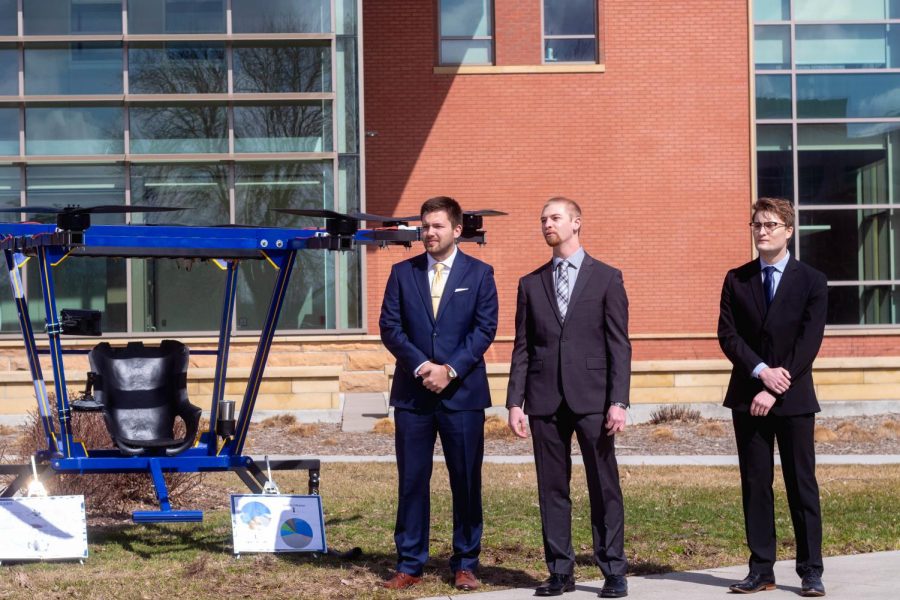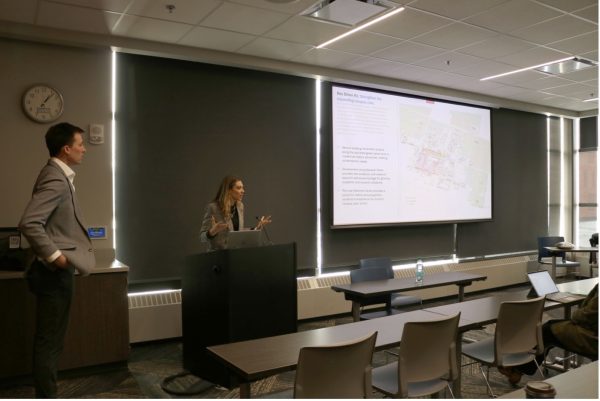Project Albatross: Students take to the skies for future of transportation
March 30, 2021
Five students publicly showcased their prototype for an autonomous, human-carrying drone, an engineering senior design project currently two years in the making.
“The goal of this project was to be one of the first researchers into autonomous, aerial and affordable transportation,” senior mechanical engineering major Evan Steers said. “When cars were first invented, it took decades for them to outnumber the transportation that was already on the road – horses … It’ll still be a few years before [human-carrying drones] are widely available to people of all classes, but when we get to that day, we hope to look back and have had a positive impact on the journey that takes us to the skies.”
The full-scale drone, named “Albatross,” is the product of two years of student work in the Jerome J. Lohr College of Engineering’s senior design program. The 2019-20 senior design group, made up of Isaac Smithee, Wade Olson, Ryan Twedt and Nick Runge, began the project with a submission to the National Aeronautics and Space Administration’s University Student Research Challenge, ultimately rewarding the team with an initial $79,995 budget.
The 2020-21 team, Cody Blocker, Andrew Hanshaw, Joshua Gross, Nathan Sydow and Evan Steers, continued the work.
“They were able to give us this frame, which we repainted and added a few things to, and we were also given the small hummingbird prototype for our electronics,” Nate Sydow, senior electrical engineering major, said. “From that, we have been able to make everything from motor mounts to battery mounts, we integrated a new seat and landing gear and we’ve done testing for every single subsystem to verify safety and to verify that everything should work properly on the first try.”
But the team didn’t start by simply building a large-scale drone.
Two small-scale drone prototypes, “Hummingbird,” the 2019-20 team’s proof-of-concept drone, and “Sparrow,” the team’s prototype for the second-generation frame design, are being used for the design process and initial testing.
“We’ve done autonomous testing and manual testing on Hummingbird recently,” Sydow said. “So, since that is a success, we transplanted all the electronics from that and put it on Albatross, and we will work towards getting all the electronics hooked up and work towards manual flight testing soon.”
For flight control, Albatross uses a joystick in manual flight mode or a tablet for autonomous flight. According to the group, an app called QGroundControl will allow users to set their desired landing sight.
Though most of the drone is nearly complete, it will be a few more months before Albatross can take off.
“We’re waiting on a few more batteries, and then once that’s done we’ll have all the power needed to take this off,” he said. “From there, we’ll do some spinning up the motors to verify that everything spins the correct orientation, nothing starts on fire, those sorts of things … From there, hopefully do some manual flight tests once we are able to get through with the Federal Aviation Administration to allow us to fly.”
Albatross specifications:
- Take-off weight: 660 lbs
- Empty weight: 440 lbs
- Payload: 220 lbs
- Flight time (Hover): 18-19 minutes
- Flight time (Cruise): 14-15 minutes
- Flight time (Max Velocity): 7-8 minutes
- Cruise velocity: 30-40 mph
- Max velocity: approx. 65 mph
- Range: 8-9 miles
- Flight Modes: Manual and Autonomous
- Total project funding: $ 149,688
- Parts cost: $ 20,424




















